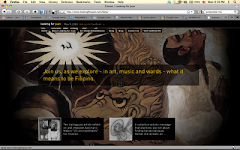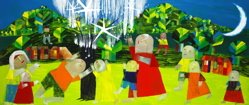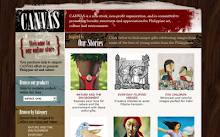
Happy New Year!
Start the year right and join
CANVAS' 5th Annual Romeo Forbes Children's Storywriting Competition! This year's contest is based on an original untitled oil on canvas painting by Juanito Torres (pictured above - click on the picture to see a larger version).
Please read the rules carefully… there are a number of changes from our previous competitions, not least of which is a P5,000.00 increase in the cash prize. :-)
In addition to receiving P35,000.00 in cash and a trophy, the winning author will also see his/her story rendered and published as a full color children's book in mid-2010.
CONTEST RULES:1. The 2009 Romeo Forbes Children’s Storywriting Competition is open to all Filipinos.
2. Entries must not have been previously published, and all entrants must warrant the originality of their submitted entries.
3. Writers may submit only one entry, in English or Filipino, which shall be limited to 1,800 words or less.
4. There is no particular theme, other than the use of this year’s contest piece by artist Juanito Torres as the inspiration or basis for the entry.
5. Judging Process.
• A CANVAS review panel shall read and award points for stories received based on the following criteria:
o Originality and Storyline (40%)
o Imagery (30%)
o Quality of Writing (20%)
o X-Factor/Judges’ discretion (10%)
• Based on the points received, CANVAS shall forward a shortlist of at least five stories with the highest scores to the Artist. The Artist shall then provide comments on any or all the stories, for consideration by the panel of judges.
• The panel of judges - taking the contest criteria and Artist comments into non-binding consideration - shall collectively choose the winner from the shortlist of stories.
• If the judges cannot come to a consensus on the winner, they shall take a vote and the entry that gains the most number of votes shall be declared the winner.
• None of CANVAS’ review panel, the judges or the Artist shall see the entrant's name until the winner is chosen.
6. Entries must be submitted by email, as a Microsoft Word attachment, to storycontest@canvas.ph with the subject heading 2009 ROMEO FORBES CHILDREN’S STORYWRITING COMPETITION.
Only the story title should appear on all pages of the entry, except for the cover page on which the entrants shall indicate their name, mailing and email address, telephone number, and the title of their submitted story.
7. The deadline for submission of entries is 5:00 p.m. (Manila time), Friday 20 March 2009. Note: CANVAS sends an acknowledgement for each and every entry that we receive. If you submitted a story, and did not receive an acknowledgement from us within 24 hours, please assume that your story was not received and kindly resend it to us.
Nevertheless, entries received after the deadline, even if sent earlier, will no longer be considered for the competition. CANVAS shall not be responsible for entries which are not received, or which are received after the deadline, due to technical failure or for any other reason whatsoever.
8. Subject to Rule 13 below, by submitting an entry, all entrants thereby agree to authorize CANVAS to post such entries on its website or blog, as CANVAS deems fit, and free from any payments, royalties or fees whatsoever.
9. There shall be only one winner, who shall receive a cash prize of PhP 35,000.00 (less the applicable withholding tax) and a trophy for his/her entry. The winner shall be responsible for all applicable taxes.
The winning writer shall also be entitled to five (5) free copies upon publication of the book.
The winner shall grant and transfer to CANVAS all intellectual property and publication rights to the story, including the right to translate, adapt and/or make modifications thereto. (Please see our short note on why we have this rule.)
It is hereby understood that the cash prize to be awarded to the winner shall include consideration of such intellectual property and publication rights to the story, and the writer shall not be entitled to any other royalties or fees from earnings, if any, that may result from future publication of, derivative works, licensing of, or other transactions on the same.
Except for the right to publish any received entry on its website and/or blog, CANVAS shall not retain any other rights to entries that are not selected as the winner, except where separate agreements are reached with the writers.
10. CANVAS shall exercise full and exclusive editorial and artistic control over the publication of the winning entry and resulting book.
11. While it is the full intention of CANVAS to publish the winning entry as a full-color children’s book, CANVAS reserves the right not to publish the same for any reason whatsoever.
12. The winner of the CANVAS storywriting competition will be announced on or around 20 April, 2008. The winner will also be notified via email on the same announcement date.
13. CANVAS reserves the right not to award the top competition prize in the event that the judges decide that no entry was received that is deserving of the top prize. In such event, however, CANVAS shall have no right whatsoever over all entries that were received; and shall not publish any entry, in its website or in any other venue, without the prior written consent or agreement of the author.
14. The decision of the competition judges shall be final, and no correspondence or inquiries into the same – including requests for points received/comments/feedback on received entries – shall be entertained.
15. Employees of CANVAS, 1/of Gallery and members of their immediate family, as well as the Artist’s immediate family, are disqualified from participating in the competition.
Why We Ask for the Transfer of Rights
The competition rules clearly state that the winning author should agree to transfer all rights to CANVAS and "...shall not be entitled to any other royalties or fees from earnings, if any, that may result from future publication of, derivative works, licensing of, or other transactions on the same."
This rule has understandably raised quite a few eyebrows in the writers' community, and this note is just to clarify where it is that CANVAS is coming from.
First of all, having complete ownership of the story rights makes it easier and less complicated for us to quickly and liberally share and give our consent to anyone who may ask for permission to use the winning story (something that we have always granted in the past).
It is for this very reason that the stories and illustrations of books we publish are all available for free viewing and enjoyment on our website (www.canvas.ph), despite the concern of some that the easy availability of the stories on the Internet could eat into the sales of our books (which, happily, has not proven to be the case).
We will now take it one step further.
Just as we did for Message in the Sand, we will make all our stories available and downloadable on our website FOR FREE, in both English and Filipino. Just as we were fortunate enough to have been given permission to adapt "The Man Who Planted Trees," into our maiden publication -
“Elias and His Trees,” - we hope that the stories that we work on will inspire similar creativity.
A second reason why we ask for the transfer of rights is that CANVAS is a small NGO, and is not equipped to document and track royalty shares that ideally should accrue to authors and artists. In fact, we only rely on and trust our partner publisher(s) to remit to us our own royalty shares. It is for this reason that our prizes (we think), are quite substantial and approximates (if not exceeds) what writers would normally expect to receive in royalties.
Third, we are also trying to get the stories published abroad. Now, should we get really lucky and end up on the NY Times Bestseller List or say, get our book selected by Oprah, we will make things right with the artist and writer (you’ll just have to trust us on this)… but until then, having demonstrably complete ownership over the rights, again, makes it easier and less complicated for us to approach and negotiate with would-be publishers (who hopefully would not be spooked by our giving out downloadable e-books for free in the first place).
Finally, we are also trying to be financially sustainable. We rely on a small amount of grant funding to conduct our activities, including co-sharing the publication costs of the books. We can only hope to recoup the expenses so that we can do these activities on a continuing and recurring basis in the years to come.
Please be assured of our continuing effort to balance our desire to contribute to the public domain in a manner that is also fair to the writers and artists, on the one hand; and our need to also be fiscally responsible with the grants that have been entrusted to us, and to the publishers that we partner with, on the other.



































